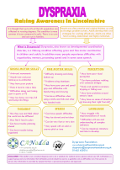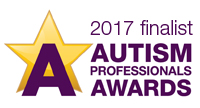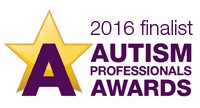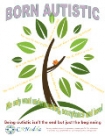Dyspraxia
Neurodiversity is about how our brains process information and how we think, as we can be wired differently. This includes concentration, language, sound, images, light, texture, colour, touch, smell, taste, perception, sequencing and movement. One major neuro-diverse type is listed below
Dyspraxia may also be known as clumsiness. It’s generally recognised to be an immaturity or impairment of the planning, organisation of movement and co-ordination. It affects the following areas:

Gross & Fine Motor Skills – How they move their bodies.
Perception & Thought – How they see and think about the world.
Speech & Language – How they speak and use words.
Up to 6% of the UK population are thought to be affected, with up to 2% severely.
In many ways, people who have dyspraxia are similar to those who have dyslexia: they are often creative and original thinkers as well as strategic problem solvers. Adults develop their own strategies for working effectively. Adults are often hard working, determined and highly motivated.
No matter how intelligent men and women are they can still feel misunderstood and vulnerable.
Facts:
- Dyspraxia is not a mental illness. It is a developmental disorder, and associated with learning difficulties. It is of genetic connection, therefore cannot be ‘caught’.
- Individuals may have more than one neuro-diversity, as they overlap each other.
- Every Job Centre Plus office has a Disability Employment Adviser who specifically deals with people with health conditions. They don’t just help people find work, they also help people keep their jobs.
- In 1995, the UK passed the Disability Discrimination Act, making it illegal to deny people employment based on disability. Employers in the UK are required to anticipate and make “reasonable adjustments” for people with disabilities.
The above is about raising awareness in Lincolnshire and not intended as a medical document or advice. If you need any advice with regards to a medical or psychological problem, please contact your GP.
Please note that if you ever use Twitter or Facebook, please DO NOT give out any personal details or information about yourself, as CANadda will not be held responsible for anything that happens. Remember to use social networking sites wisely.
Downloads
 Download a poster on Dyspraxia
Download a poster on Dyspraxia
Contacts:
Dyspraxia Foundation
8 west Alley
Hitchin
Herts
SG5 1EG
Helpline: 01462 454986 (Mon-Fri 10am - 1pm)
Admin: 01462 455016
Website: dyspraxiafoundation.org.uk
Email: dyspraxia@dyspraxiafoundation.org.uk
Useful Links:
- www.dyspraxicadults.org.uk
- www.dyspraxicteens.org.uk/forum/
- Also on facebook if you type dyspraxia into the search bar, it will come up with about 22 extremely informative pages with lots of useful hints and tips for parents with young children and adults alike.
- Type the dyspraxia support group of New Zealand into Google.
- Talks on Dyspraxia by professionals.
- Driving with Dyspraxia.
Famous people who suffer from Dyspraxia
“I was having a hard time at school in terms of being c**p at everything, with no discernible talent.” Daniel Radcliffe.
It was revealed on August 16, 2008, that actor Daniel Radcliffe, best known for playing Harry Potter, suffers from a disorder known as dyspraxia. This disorder affects an individual’s neurological function and disrupts the normal developmental process.
Other famous people include Florence Welch (singer in the new and now world famous band known as Florence and the machine).
David Bailey the legendary photographer who has worked with artists such as Twiggy, the Rolling Stones, Kate Moss and the Beatles.
Another is Samuel Taylor Coleridge who is a famous poet.
G.K Chesterton who is a best selling author and theologian.
Marco Pierre White who is a very well knows chef and has 2 Michelin stars and various restaurants around the UK.
It is thought that Odysseus possibly may have had dyspraxia too.
The world famous billionaire entrepreneur Richard Branson is thought to suffer from dyspraxia.
Albert Einstein is known to have dyspraxia along with Jack Kerouac; Emily Bronte; Ernest Hemingway, and George Orwell.
The following article comes courtesy of the Dyspraxia Foundation website.
Dyspraxia in the Workplace
A guide for employers
Up to 6% of the UK population have some symptoms of dyspraxia. It is probable that people who have dyspraxia work for your organisation. The Dyspraxia Foundation has developed this guideline to raise awareness amongst employers and to provide support to employees.
Adults with dyspraxia are often determined, hard working and highly motivated they develop their own strategies for working effectively. In many ways, people who have dyspraxia are similar to those who have dyslexia: they are often creative and original thinkers as well as strategic problem solvers.
How can employers help?
- Make sure instructions are concise and wherever possible provide timetables, mnemonics and mind maps as these help people with dyspraxia to prioritise their work and meet deadlines. They should be encouraged to write instructions down clearly and to keep them for easy reference.
- Employees who have dyspraxia respond well to routines. They benefit from provision of a structured timetable and the opportunity for training in time-management.
- People with dyspraxia should be encouraged to break down their work into manageable chunks and to use different coloured folders for different tasks to help with organisation. Allowing regular breaks can improve productivity.
- Word processors, which have grammar and spell checks, can be of great use, as can speech recognition and proof reading programs. Templates can be used for detailed work such as reports and provide a framework for writing.
- The person’s position at the word processor/computer should also be taken into account. Ergonomics keyboards can be of great benefit to all employees as can changing or slowing down the mouse. Keyboard short cuts can also be used as an alternative to the mouse.
- If employees with dyspraxia use machines such as fax machines and photocopiers, keep a list of the operating procedures nearby. This is helpful for all employees.
- It may be possible to arrange for employees with dyspraxia to come in early or to stay late, to reduce distraction. Perhaps they can have a partition around their desk, own room or allow them to wear earphones to reduce distractions.
- Encourage your workers who have dyspraxia to approach tasks in a calm and positive manner.
The provisions of the Disability Discrimination Act cover those people whose ability to carry out normal day-to-day activities is adversely affected by a physical or mental impairment on a long-term basis. Under the terms of the Act, an employer must make reasonable adjustments to accommodate a disabled persons needs. Support can sometimes be provided for the individual and paid for by the Employments Service’s Disability Team.
Above all, employers need to ensure that their employees with dyspraxia have the opportunity to develop their strengths and are given appropriate support to minimise the impact of their symptoms.
Developmental dyspraxia is an impairment or immaturity of the organisation of movement. It is an immaturity in the way that the brain processes information, which results in messages not being properly or fully transmitted. The term dyspraxia comes from the word praxis, which means ‘doing, acting’. Dyspraxia affects the planning of what to do and how to do it. It is associated with problems of perception, language and thought.
Dyspraxia is thought to affect up to Six per cent of the population and up to two per cent severely. Males are four times more likely to be affected than females. Dyspraxia sometimes runs in families. There may be an overlap with related conditions. Other names for dyspraxia include Developmental Co-ordination Disorder (DCD), Perceptuo-Motor Dysfunction, and Motor Learning Difficulties. It used to be known as Minimal Brain Damage and Clumsy Child Syndrome.
Statistically, it is likely that there is one child in every class of 30 children. We need to make sure that everyone understands and knows how best to help this significant minority.
The cerebral cortex is the large uppermost area of the brain. The cerebral cortex can be divided into four distinctive areas. These are; the motor area, the frontal lobe, the sensory area and the hind cerebral cortex. As the name suggests, the frontal lobe is situated at the front of the brain. Both the motor and sensory areas are bands radiating across the brain, immediately after the frontal lobe. Behind the sensory cortex is the hind cerebral cortex, where the auditory and visual areas are held deep within the brain itself.
Impulses from sensory organs are relayed to the cerebral cortex by means of a network of pathways of nerve fibres. In the course of growing and learning, the connections between the nerve cells (neural pathways) become established. They are reinforced when the desired outcomes are achieved – for example, a child learning to process the complex series of movements required to pick up a cup and drink from it. Constant repetition allows the planning of these actions to become almost reflexive. Using external sensory input e.g. sight and sound, together with these ‘learned’ patterns of movement, the cerebral cortex is able to judge the best course of action to take. It then sends out the appropriate motor impulses.
The cerebral cortex is divided into a right and left hemisphere, which have specialist functions. They operate in an almost separate fashion. Many functions are ‘shared’, but generally each side appears to work almost independently offering its piece of information to complete the ‘picture’ and therefore forming a whole, e.g. the left hemisphere receives the information, in a jumbled, disjointed way; it is only when the right hemisphere works in harmony with the left that images and actions are interpreted in the correct order and the information is comprehended as a complete piece or object.
Individuals with Dyspraxia do not seem to have both hemispheres responding in this simultaneous, co-ordinated fashion. It is also the development of the two hemispheres that decides whether a person is right or left handed, again this basic development seems substantially reduced and therefore the child may use both hands without preference for some time, thus reducing the development of hand-writing skills still further.
The cortex also surrounds structures known as the ‘thalamus’, ‘hypothalamus’ and ‘pituitary gland’. This area it known as the limbic system. This system is responsible for the ‘instinctive’ and automatic responses within the body: it is also closely linked with emotional behaviour. As the cortex matures is acts to ‘dampen down’ the effects of the limbic system’s emotional output in response to stimuli. If this were not the case, the individual would be highly excitable, over emotional and be extremely sensitive to external sensory input.




